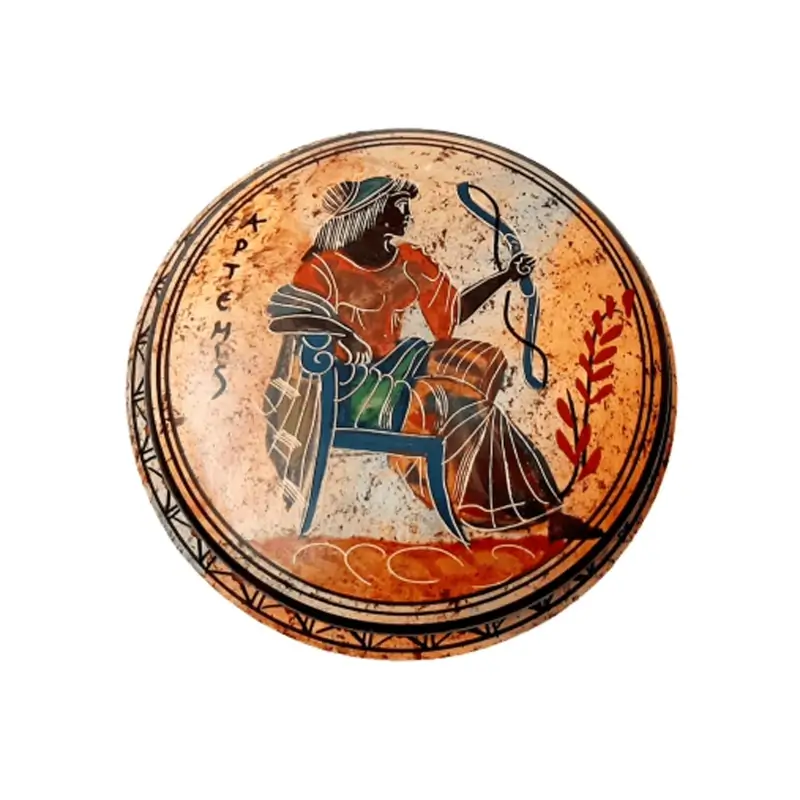Pyxis: The Ceramic Vessel of Antiquity

The pyxis or pyxis is an ancient Greek container, usually ceramic, without handles and with a lid, used to store ointments, cosmetics and jewelry.
Characterized by its variety in shapes and sizes, it stands out for its decorations, often with female scenes, reflecting the culture and art of classical Greece.
Its origin dates back to the protogeometric period in Athens, evolving over the centuries.
Origins and Evolution of the greek pyxis
A Tour through History
The history of the pyxis dates back to the period protogeometric in Athens, where its precedent is found in the Corinthian boxes. Athenian pyxis, which have two main varieties -one with a conical bottom and the other with a flat bottom-, have evolved over the centuries, reflecting changes in styles and uses.
The term pyxis that we use today is derived from the Latin “pyxis-ĭdis” and the Greek “πυξίς, -ίδος”.
9th Century B.C.: The Beginnings
The earliest Athenian pyxis, with a conical bottom, date from before the 9th century B.C. and show the simplicity and minimalism of the pottery of that time.

Buy unique Greek reproductions
Fortunately, there are artisans who make reproductions identical to the classical works of art that were made in ancient Greece and are only found in museums, making them affordable.
Final Geometric and 6th Century B.C.: The Transformation
With the passage of time, especially during the Final Geometric and the 6th century BC, the pyxis was transformed. Athens began to produce pieces with concave walls, a significant change in its design.
Details and Decoration
The pyxe or pyxide is characterized by having no handles, although the lid often features elaborately carved handles. The walls are decorated on the outside with scenes from Greek mythology and history, and sometimes the lid has a button in the center.
An Object with Multiple Meanings
Beyond its practical use, the pyxis is an object loaded with symbolism. The decoration of these pieces often includes feminine and ceremonial scenes, such as wedding processions. This artistic choice not only reflects the aesthetics of the time, but also the cultural importance of women in Greek society.
The Pyxis in Art and Culture
One Vessel, Many Stories
Each pyxis tells a story. Through their decorations and shapes, these vessels offer us a window into the ancient world, showing us how beauty and functionality can merge in an everyday object.

This piece and the one on the cover are the work of Ancient Greek Ceramics.
Anecdotes and Curiosities
An interesting anecdote about pyxides is how their design and decoration reflect not only the fashion and tastes of the time, but also the social status of their owner. A more elaborate and detailed pyxid was often a sign of greater wealth or social standing.
The Pyxis Today: Legacy and Appreciation
Although it is an object of antiquity, its charm and relevance endure over time and its forms have influenced many ceramists of all times. It should be remembered that it has had uses in different later cultures, for example, it is commonly used in Christianity as a Ciborium in which the Blessed Sacrament is kept, for example, to take it to the sick.
Today, the pyxis is appreciated not only as a collector’s item, but also as a source of inspiration for contemporary artists and designers.
We hope you liked this post. It will help us if you share it on social networks .
Note: This article contains links that lead to the artists’ stores on other sales sites than Ceramicartis. If you make a purchase there, we will receive a small commission that will help us to continue with the website and in turn to continue to support your work. This no increases the artist’s selling price.
Related publications:


